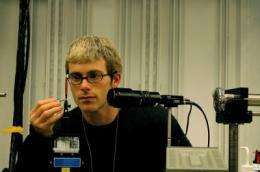Gut movements in caterpillars inspire soft-body robot design (w/ Video)

"Weird movements" in the abdomens of freely crawling caterpillars are making headlines in the fields of engineering and biology, says Jake Socha, Virginia Tech assistant professor of engineering science and mechanics. Beyond evolutionary implications, the findings are already contributing to the design and development of soft material robots.
The work of an interdisciplinary research team, including Socha, lead author Michael Simon of Tufts University's Department of Biology, and senior author Barry Trimmer, professor of biology at Tufts in whose laboratory the research was done, is appearing in the August 28, 2010 issue of Current Biology. The online publication appears July 22.
Describing their findings, the researchers said they used a type of powerful X-ray imaging to discover internal soft-tissue movements that were massively out of sync with the external body movements. The need for X-rays was because large caterpillars are entirely opaque. They then verified these findings using transmission-light microscopy to see the internal soft-tissue movements of smaller, translucent caterpillars as they slowly inched their way along a glass microscope slide. As the dissection microscope magnified the images, the researchers recorded them to a video camera, and then captured them on a computer.
This combined imaging showed that the caterpillar's gut slid forward in advance of the surrounding tissues. Seem inconsequential? Actually, it is "unlike any form of legged locomotion previously reported and represents a new feature in our emerging understanding of crawling," they reported in Current Biology.
The novelty is that the caterpillar's center of mass moves forward while the middle 'legs' are anchored to the substrate. The internal gut movements are locally decoupled from visible translations of the body. "This type of two-body mechanical system has never been seen before, and is probably unique to soft, squishy animals," Socha explained.
Using powerful x-rays generated by the Advanced Photon Source at Argonne National Laboratory in Argonne, Illinois, they were actually able to track the tracheae of the caterpillars. These gas-filled tubes inside the slow-moving insects supply all the tissues of their bodies with oxygen and vent carbon dioxide to the exterior via spiral openings in their body walls. The tracheae proved to be reliable markers that connected to both the body walls and the guts of the caterpillars.
Socha said they "quantified the relative timing of the gut, body wall, and proleg movements during the individual crawls. Each crawl began with a step by the rear 'legs' followed by a forward-moving wave of overlapping contractions and middle 'leg' steps in successive segments.
"Remarkably, at the start of each crawl, the gut in mid-body segments moved in advance of the body wall and prior to the middle 'leg' swing phases."
This movement meant the abdomen typically advanced an entire step forward before the body wall caught up. The researchers described it as "a unique phenomenon of gut sliding."
Since the research team is also interested in engineering applications, they moved from considering the biological implications of an internally pistoning gut to potential uses in soft-bodied robots.
Their findings are already finding their way into designing maneuverable and orientation-independent soft material robots. The next step for these 'softbots' includes a diverse array of potential uses, such as shape-changing robots capable of engaging in search-and-rescue operations, space applications for which a 'gravity-agnostic' crawler would be highly valued, and medical applications in which a biocompatible, soft robot would reduce incidental tissue damage and discomfort.
More information: Simon Michael A, Woods William A Jr, Serebrenik Yevgeniy V, Simon Sharotka M, van Griethuijsen Linnea I, Socha John J, Lee Wah-Keat, Trimmer Barry A, (2010), "Visceral-locomotory Pistoning in Crawling Caterpillars (Manduca sexta)", Current Biology, DOI:10.1016/j.cub.2010.06.059
Provided by Virginia Tech















